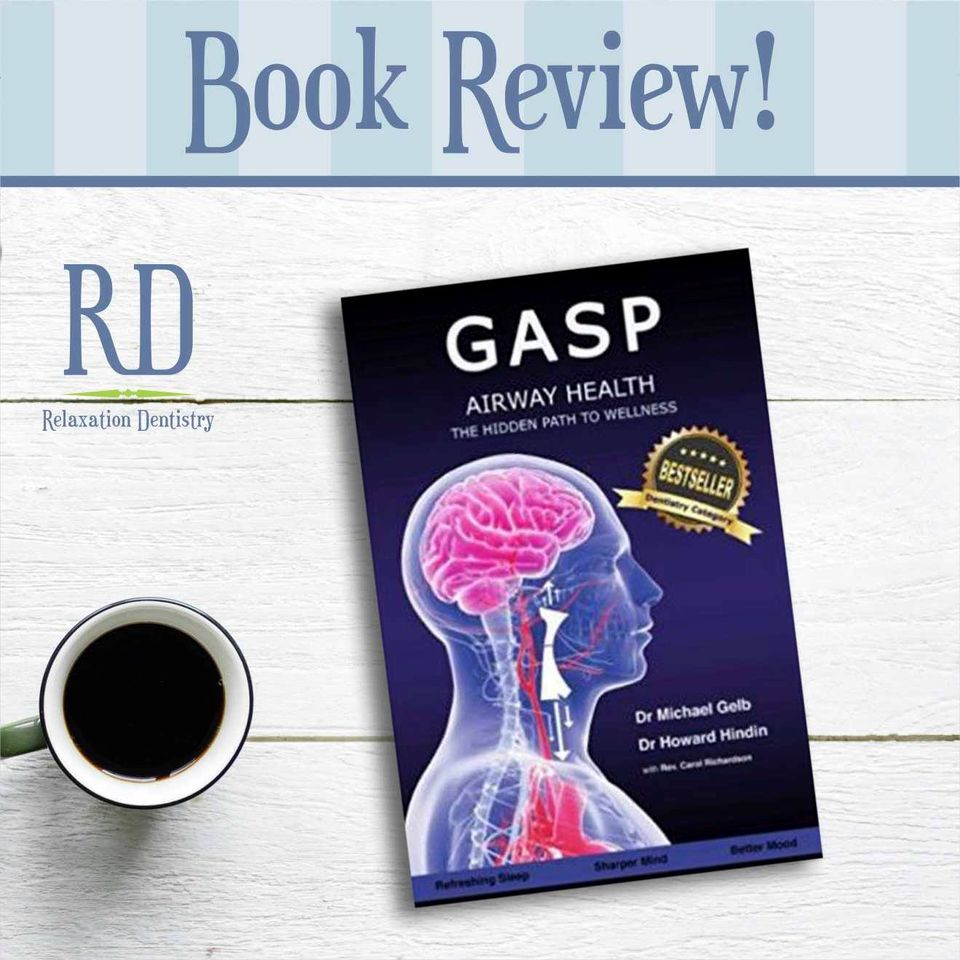I recently read a book called Gaspby Dr. Michael Gelb and Dr. Howard Hindin that was published in 2016. There is an increasing focus on airway and breathing by dental professionals because the number of patients with snoring and sleep apnea is on the rise. According to Gasp, “improper breathing and sleep patterns adversely affect health, mood, energy, focus and function, and if untreated will ultimately lead to multiple systemic disorders.”
According to Gasp, you may have sleep disordered breathing (SDB) if you have any of the following symptoms: Headaches, snoring, difficulty sleeping, neck, jaw, ear pain, sugar cravings, junk food cravings, obesity, type 2 diabetes, cardiovascular disease, difficulty focusing mentally, excessive daytime sleepiness, low energy, or wake up feeling unrefreshed.
Gasp states that “Airway-centered disorder (ACD) is a physiological disorder of the mouth, jaw, nasal passages, tongue, or throat that leads to breathing difficulties, including mouth breathing, snoring, sleep apnea, hypopneas, and upper airway resistance syndrome (UARS)….ACD can lead to learning and behavioral disorders such as attention deficit hyperactivity disorder (ADHD). It is also a causative factor in obesity, allergies, asthma, diabetes, and Alzheimer’s disease.” The book further asserts that “ACD and sleep-disordered breathing are preventable and treatable at any age.”
The book speculates that the rise in ACD is due to a softer diet today than our ancestors had, as well as a decrease in breast feeding because “a newborn’s sucking action, which is not replicated in bottle-feeding, develops muscles critical to proper airway development”. The softer diet theory is “based on studies of human skulls from different time periods and cultures” as well as a study conducted by researchers Boyd, and Harvard evolutionary biologist Daniel Lieberman who performed a study on pigs. They fed “one group a soft diet and one group foods that were tough to chew. The group that ate tough food developed not only stronger muscles but also larger jaws, while the group with soft foods developed weaker, smaller jaws….Smaller jaws leave less room for teeth, causing crowding. They also leave less room for the tongue, forcing it to move backwards, especially during sleep, where it tends to block the airway.”
Other factors that contribute to ACD is the extraction of teeth prior to orthodontics (braces), and “Even removing wisdom teeth can contribute to a smaller jaw….because when teeth are pulled, the jaw becomes smaller. A smaller jaw means a smaller airway.” Other contributing factors to ACD are: Bottle-feeding, weaning to soft foods, thumb-sucking, pacifier use and mouth breathing.
Why is ACD so unhealthy? “…having difficulty breathing during sleep makes the brain think it is threatened. It is as if the next breath may never come! That threatened brain immediately turns on all of the body’s survival instincts, the fight-or-flight response. It tells the adrenal glands to release a flood of the stress hormone, adrenaline, putting us into full panic mode. Over time, that adrenaline has toxic effects and causes the body’s immune responses to run wild and create inflammation throughout the body.” “The sleep process becomes a time of crisis rather than a time of rest, repair, and restoration.” This is why people with ACD wake up feeling exhausted rather than refreshed.
“According to the National Institutes of Health, “obstructive sleep apnea (OSA) affects approximately 20% of US adults, of whom about 90% are undiagnosed.” Aside from prevention (primarily breast feeding for as long as possible), the book focuses on “a revolutionary system aimed at recognizing and correcting ACD” called Airway Centric.
The Airway Centric approach starts with observation in childhood. Risk factors include: Premature infant, poor breast feeding or tongue-tied infant, ear infections, allergies, developmental problems, enlarged tonsils and adenoids, open-lipped posture, slack muscles around the mouth, jaws and face, sleepy yet hyperactive….” all of these conditions indicate the potential presence or development of ACD.”
Signs of Airway Obstruction in children include the following: “Mouth breathing, open or slack mouthed posture, snoring or noisy sleep, night terrors, bed-wetting, chronic nasal discharge/runny nose, chronic ear infections, dark circles or allergic ‘black eyes’, tossing, turning, thrashing and restless sleep, messy sheets and blankets, nail-biting, crooked teeth, frequent earaches, falling asleep in school, awakening feeling un-refreshed.” “When children are snoring or breathing through their mouths, their brains and bodies cannot develop correctly.”
The book focuses on prevention of poor airway development through breast-feeding, diet, proper oral-rest posture (breathing through the nose, the teeth slightly apart, and the tongue resting or pressing lightly on the roof of the mouth), assessing adenoids or tonsils using cephalometric x-rays and 3D CT to determine if they may be blocking the airway, completing a sleep study, and to seek care by an OMT (oro-facial myofunctional therapist) and orthodontic work that consists of “guided appliance therapy” to open the airway. In addition, treating allergies or asthma, avoiding junk food and toxins, and checking the epiglottis to ensure it is not blocking the airway are other ways to prevent poor airway development.
The book recommends generally avoiding extraction of any teeth or the use of an orthodontic headgear that may retract the jaw and block the airway. Some patients may benefit from palatal expansion, which can also be referred to as “rapid maxillary expansion, functional orthodontics, and BioBloc orthotropics.”
Signs of airway-centered disorder in adults include the following: Wake up feeling tired and often have headaches, snore, wake up gasping for breath in the middle of the night, clench or grind teeth at night, wake up frequently to use the bathroom, have diabetes, high blood pressure, or cardiovascular disease, are overweight or obese, crave sugar, junk food or caffeine, often feel sleepy during the day or have trouble staying awake while driving, have difficulty concentrating or adult onset ADHD, have difficulties with allergies, sinus problems, or ear infections, mental fog, energetically drained. Gasp specifically recommends a Multiple Sleep Latency Test for adults with symptoms of ACD.
Interestingly, the book references Dr. Avram Gold, Director of the Sleep Disorders Center of the State University of New York at Stony Brook who suggests that sleep-disordered breathing may underlie many functional somatic and anxiety disorders in women such as: Chronic fatigue, fibromyalgia, restless leg syndrome, irritable bowel syndrome, migraine/tension headache syndrome, temporomandibular joint syndrome, mitral valve prolapse syndrome, war-related illness (Gulf War syndrome), multiple chemical sensitivity syndrome (sick house syndrome), joint hypermobility syndrome, panic disorder, generalized anxiety disorder, social phobia, post-traumatic stress disorder and obsessive-compulsive disorder.
Other sub-topics included in the book are women and sleep disordered breathing (SDB), as well as upper airway resistance syndrome, pregnancy, menopause, breast cancer, Alzheimer’s, autism, Down’s syndrome, chronic pain, and inflammation and how these conditions are connected to SDB.
It is clear that good quality sleep affects almost every aspect of our lives and overall health. There is a movement within dentistry as a whole that now considers how changes in the alignment of the teeth (i.e. extracting wisdom teeth or other teeth as well as changes that happen with orthodontics) may affect the airway.
Many dentists today offer oral sleep appliances that help to open the airway to reduce snoring, sleep apnea or other airway centered sleep issues. Most appliances open the airway by pulling the lower jaw forward in relation to the upper jaw. Pulling the lower jaw forward; however, is contradictory to the established best jaw position for patients with temporomandibular joint disorders and facial pain which is having the lower jaw in a back or detruded position.
It is my opinion that more understanding about the long-term effects of pulling the lower jaw forward when using an oral sleep appliance need to be understood. The use of oral sleep appliances for reduction of snoring and sleep apnea symptoms were not fully addressed in Gasp.
The focus of the book was primarily on the prevention of airway issues in developing children along with signs and symptoms that may be indicative of an airway centered disorder. Several treatment options were also mentioned but it was not within the scope of the book to give detailed explanations of the options available for treatment. Options may involve surgery, appliances, behavioral support, breathing techniques, myofunctional therapy, orthodontics and a multi-disciplinary approach to care involving allergists, ENT, sleep medicine doctor, orthodontists, general dentists, other health care providers, and parents.
To find out more about airway health, visit www.airwayhealth.org and www.AAPMD.org. To learn more about the authors, Michael Gelb, DDS, MS and Howard Hindin, DDS visit www.gelbcenter.com and www.hindincenter.com.




